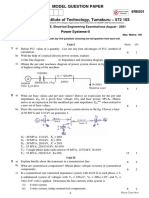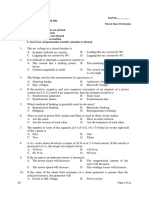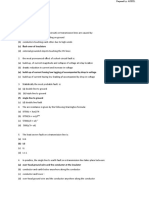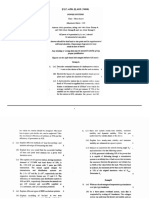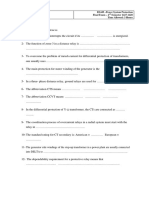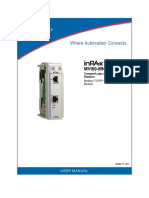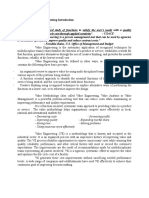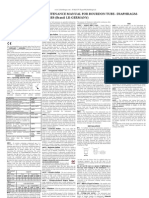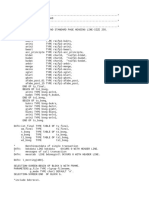Three Hours
THE UNIVERSITY OF MANCHESTER
INSTITUTE OF SCIENCE AND TECHNOLOGY
Department of Electrical Engineering and Electronics
Semester 1 Examination
Degree of
M.Eng. HONOURS (Final)
in
ELECTRICAL AND ELECTRONIC ENGINEERING
Paper No. EE 7402
HIGH VOLTAGE ENGINEERING AND
POWER SYSTEM PLANT
Wednesday 17th January 2001, 9.30 a.m.-12.30 p.m.
Answer FOUR questions,
not more than TWO from each Section.
Use a SEPARATE answer book for each Section.
Only the Casio fx-82 Super or fx-83WA calculators issued to
students by the Department may be used in this Examination
EE 7402 Page 1 of 7
� SECTION A
(Dr. P.A. Crossley)
1. The operating behaviour of an overcurrent relay is characterised by the
equation : I 2t = K where I is the current in primary amperes, t is the time in
seconds and K is a constant that can be set in integer multiples of 107 A2s.
Determine the settings (i.e. the K constants) for the overcurrent relays at
substations B and C in Figure Q1, if the relays are used for both main and
back-up protection. Assume the fuses in substation A are rated at 600A and
the clearing time at current levels greater than {3 x rating} is 100 ms.
Assume the co-ordination margin between two relays, or a relay and a fuse,
is 20% of the operating time of the downstream relay or fuse plus a fixed
time of 200 ms.
For the relay at substation B calculate the operating time for a solid fault at
substations A and B.
For the relay at substation C calculate the operating time for a solid fault at
substation A, B and C.
Assess whether the relay at C provides adequate back-up protection for the
feeder between B and A (assume the operating time for back-up protection
must be less than 1s).
Finally, discuss whether the relay at B provides adequate back-up protection
for solid faults downstream of a fuse. Note : this will depend on the
minimum value of the downstream current, hence calculate the minimum
value for which appropriate back-up protection is achieved.
C B Fuse
A
50 MVA, 10%
2000 m
Relay Fuse
1000 m
Relay
11 kV
132 kV 11 kV 11 kV
5000MVA
Figure Q1
Cable C-B = 2000 m at 0.1Ω/km
Cable B-A = 1000 m at 0.2 Ω/km
EE 7402 Page 2 of 7
�2. A three phase 132 kV :11 kV power transformer is rated at 20.0 MVA. The
132 kV winding is delta connected and the 11 kV winding star connected
with a zero ohm earth connection. The transformer incorporates a tap-
changer on the 11 kV side capable of varying the turns ratio over the range
–10% to +10% in 1% steps.
The transformer is protected by a 3-phase biased differential relay with
current settings of 20% to 100% of the nominal current (5.0A) and a
percentage bias of 10% to 40%, both settings can be adjusted in 10% steps.
Sketch a diagram showing the arrangements of the current transformers
(CTs), the CT secondary wiring and the connections to the relay. For an
(a-b) phase fault on the line side of the 11 kV terminals annotate your
diagram to show the direction of current flow in all the 11 kV, 132 kV and
relay wiring connections.
Evaluate the turns ratio of the 11 kV and 132 kV CTs if the relay is used
without interposing CTs and the CTs are selected from ones of standard ratio
(100:5 to 2400:5 in 100A steps).
If the error from a CT at the nominal current value is ±1%, and at the
maximum fault current is between –5% and +1%, calculate the “worst case”
current that flows through the operating winding of the relay if the
transformer is supplying a rated MVA 11kV load.
Finally determine suitable percentage bias and pick-up current settings for
the relay.
EE 7402 Page 3 of 7
�3. A generator is rated at 100 MVA, 11 kV and the sub-transient reactance is
j0.2 per unit based on the machine rating. The generator stator winding is
protected by high impedance differential relays configured to provide phase
and earth fault protection.
Assume the ratio of all the current transformers is 800/5, the secondary
winding resistance of each CT is 0.4 ohms, the loop resistance of the leads
used to connect each CT to a relay is 0.5 ohms and the secondary voltage
(Vs) versus excitation current (Ie) characteristic for each CT is :
Vs = 25 50 100 150 200 250 V
Ie = 5 10 22 36 60 100 mA
Determine the ohmic value of the stabilising resistor required to ensure the
high impedance differential relays remain stable for through faults; assume
the operating voltage of the relay is 50V and the operating current is 25 mA.
Evaluate the current that will flow into a single phase-earth fault located at
the line terminals of the stator winding and within the differential protection
zone; assume the generator is earthed using a single phase 6.3 kV/240V
distribution transformer with a secondary burden resistance of 0.1 ohms.
Note : the generator is connected to a network with no other sources of
generation using a delta-wye transformer.
Finally evaluate the percentage of the winding protected by this relay for a
single phase-earth fault.
EE 7402 Page 4 of 7
� SECTION B
(Dr. I. Cotton and Dr. Z. Wang)
4. (a) Briefly describe the heat sources in a high voltage power cable.
Indicate how they vary according to load current and system voltage.
(b) A 50 Hz 400 kV power cable has the parameters stated below.
Calculate the following :
(iii) Resistance of the conductor per unit length
(iii) Dielectric current required per unit length
(iii) Dielectric losses per unit length
• Conductor resistivity : 1.72 x 10-8 Ωm
• Equivalent conductor cross-sectional area : 250 mm2
• Phase to earth capacitance : 93.9 pF/m
• Thermal resistance of insulation (T1) : 1.20 K/W
• Thermal resistance of oversheath (T3) : 0.08 K/W
• Thermal resistance of ground (T4) : 0.70 K/W
• Maximum temperature difference between conductor and ground : 70 K
• Dielectric loss tangent : 0.0003
(c) Using the information above, or otherwise, calculate the maximum
cable length (i.e. that will result in the cable circuit having the
capability to carry 0A load current).
∆Θ − Wd [0.5 T1 + T3 + T4 ]
I=
R( T1 + T3 + T4 )
(d) Briefly indicate how the maximum cable length could be increased.
EE 7402 Page 5 of 7
�5. (a) Briefly explain with the use of equations the interruption of DC current
in a circuit consisting of an ideal voltage source, a resistance, an
inductance and a circuit breaker.
(b) A 750V DC circuit can supply a fault current of 3.75 kA. The circuit
has negligible inductance. A circuit breaker is used to clear the fault.
This circuit breaker produces an arc with the characteristic shown
below. Calculate the values of current that could be expected at the
arc length of 4 cm.
100000 l
Varc = + 25
I
(l = arc length/cm, I = arc current/A)
(c) Calculate the arc length required to extinguish the fault.
(d) Describe the effect of the following on the ability to extinguish an arc :
(i) Placing a number of thin metal plates along the electrode length
thus splitting the arc into a number of smaller arcs.
(ii) Cooling the arc by blowing high pressure air over it.
EE 7402 Page 6 of 7
�6. (a) For an ideal transformer as shown in the following Figure Q6(a),
describe the relationship between the primary and secondary
voltages, currents and powers.
I1 I2
V1 V2
N1 N2
Ideal
Figure Q6(a)
(b) A single-phase transformer has 1000 turns on the primary winding
and 250 turns on the secondary. Winding resistances are r1 = 1.0 Ù
and r 2 = 0.125 Ù, leakage reactances are x 1 = 4.0 Ù and x 2 = 0.50 Ù.
The magnetising resistance and reactance are r m = 30 kÙ and
x m = 4 kÙ. The load, Z, is 12 Ù with a lagging power factor of 0.8.
Its equivalent circuit is shown in the Figure Q6(b). Calculate the
following :
(i) the turns ratio α,
(ii) the referred impedances r 2’ and x 2’,
(iii) the voltage at the terminals of the secondary winding if the
applied voltage at the terminals of the primary winding is
1200V.
I1 r1 x1 r'2 x'2
α:1
V1 rm xm V ’s Z V2
N1 N2
Ideal
Figure Q6(b)
EE 7402 Page 7 of 7
















